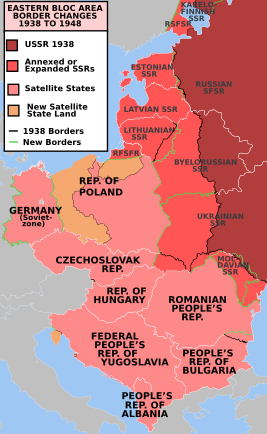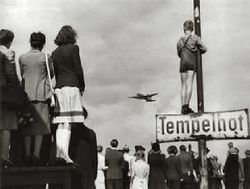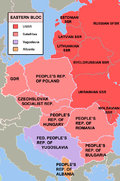الكتلة الشرقية

| الكتلة الشرقية |
|---|
 |
التعبير الكتلة الشرقية Eastern Bloc أو الكتلة الشيوعية يشير إلى الدول الشيوعية السابقة في اوروپا الوسطى والشرقية، عموماً الاتحاد السوڤيتي وبلدان حلف وارسو.[1][2][3] كما استُخدِم التعبيران الكتلة الشيوعية و الكتلة السوڤيتية للاشارة لتجمعات من البلدان المصطفة مع الاتحاد السوڤيتي، بالرغم من أن تلك التعبيرات قد تضم دولاً خارج اوروپا الوسطى والشرقية.
الاتحاد السوڤيتي والحرب العالمية الثانية في وسط وشرق اوروپا
توسع الاتحاد السوڤيتي في 1939–1940
في 1922، أقرت روسيا ج.ا.ا.س.، اوكرانيا ج.ا.س.، بيلوروسيا ج.ا.س. وجمهورية عبر القوقاز ا.ا.س.، جميعاً معاهدة خلق اتحاد الجمهوريات الاشتراكية السوڤيتية واعلنوا خلق اتحاد الجمهوريات الاشتراكية السوڤيتية، الذي شكل الاتحاد السوڤيتي.[4] الزعيم السوڤيتي يوسف ستالين، الذي رأى أن الاتحاد السوڤيتي كـ "جزيرة اشتراكية"، قال أن الاتحاد السوڤيتي يجب أن يعمل على أن "الاحاطة الرأسمالية الحالية تُستبدل باحاطة اشتراكية."[5]
الجبهة الشرقية ومؤتمرات الحلفاء

الأحداث المبكرة التي أدت لإحكام السيطرة
رفض خطة مارشال
حصار برلين والجسر الجوي
شقاق تيتو-ستالين
الاقتصادات


ن.م.إ. للفرد (دولارات 1990[6]) 1950 1973 1989[7] 1990 الولايات المتحدة $9,561 $16,689 n/a $23,214 فنلندا $4,253 $11,085 $16,676 $16,868 النمسا $3,706 $11,235 $16,305 $16,881 إيطاليا $3,502 $10,643 $15,650 $16,320 تشيكوسلوڤاكيا $3,501 $7,041 $8,729 $8,895(التشيك)/
$7,762(سلوڤاكيا)الاتحاد السوڤيتي $2,834 $6,058 n/a $6,871 المجر $2,480 $5,596 $6,787 $6,471 پولندا $2,447 $5,334 n/a $5,115 اسبانيا $2,397 $8,739 $11,752 $12,210 البرتغال $2,069 $7,343 $10,355 $10,852 اليونان $1,915 $7,655 $10,262 $9,904 بلغاريا $1,651 $5,284 $6,217 $5,552 يوغسلاڤيا $1,585 $4,350 $5,917 $5,695 رومانيا $1,182 $3,477 $3,890 $3,525 ألبانيا $1,101 $2,252 n/a $2,482
ن.م.إ. للفرد 1989 المارك الألماني[8] 1989 ألمانيا الغربية 35,877 DM ألمانيا الشرقية 15,318 DM
مصطلحات وبلدان أخرى
استخدام المصطلح "الكتلة الشرقية" يشير عموماً إلى "الدول الشيوعية في اوروبا الشرقية."[1] وأحياً، أكثر عموماً، فيشيار إليهم بوصف "دول اوروبا الشرقية الواقعة تحت الشيوعية".[9] Many sources consider Yugoslavia to be a member of the Eastern Bloc.[1][10][11][12][13][14][15][16] Others consider Yugoslavia not to be a member after it broke with Soviet policy in the 1948 Tito–Stalin split.[17]
مصطلح "الكتلة الشرقية" كان يُتبادل أحياناً مع مصطلح العالم الثاني، والتي كانت تعارضها الكتلة الغربية. أعضاء الكتلة الشرقية السوڤيت بجانب الاتحاد السوڤيتي كثيراً ما كان يشار إليهم بإسم "الدول الدائرة في فلك" الاتحاد السوڤيتي.[18][19][20][21][22][23][24][25][26][27] In the 1920s, "Eastern bloc" was used to refer to a loose alliance of eastern and central European countries.
Other countries that were not Soviet Socialist Republics, not Soviet Satellite States or not in Europe were sometimes referred to as being in the Eastern Bloc, Soviet Bloc or Communist Bloc, including:
- جمهورية أفغانستان الديمقراطية (1978 حتى 1992)
- الجمهورية العربية المتحدة (اتحاد مصر وسوريا 1958 إلى 1963)
- جمهورية العراق (1968 إلى 1992)
- جمهورية كوبا من 1960
- جمهورية الصين الشعبية قبل الشقاق الصيني السوڤيتي في 1960
- جمهورية كوريا الديمقراطية الشعبية (كوريا الشمالية) من 1945
- جمهورية منغوليا الشعبية
- جمهورية ڤيتنام الاشتراكية من 1954
- جمهورية كامپوتشيا الشعبية (1979 حتى 1990)
انظر أيضاً
الهامش
- ^ أ ب ت Hirsch, Donald; Kett, Joseph F.; Trefil, James S. (2002), The New Dictionary of Cultural Literacy, Houghton Mifflin Harcourt, p. 316, ISBN 0-618-22647-8, "Eastern Bloc. The name applied to the former communist states of eastern Europe, including Yugoslavia and Albania, as well as the countries of the Warsaw Pact"
- ^ Satyendra, Kush (2003), Encyclopaedic dictionary of political science, Sarup & Sons, p. 65, ISBN 81-7890-071-8, ""the countries of Eastern Europe under communism""
- ^
Compare:
Janzen, Jörg; Taraschewski, Thomas (2009). Shahshahānī, Suhaylā (ed.). Cities of Pilgrimage. Iuaes-series. Vol. 4. Münster: LIT Verlag. p. 190. ISBN 9783825816186. Retrieved 2012-12-21.
Until 1990, despite being a formally independent state, Mongolia had de facto been an integral part of the Soviet dominated Eastern Bloc.
- ^ Julian Towster. Political Power in the U.S.S.R., 1917–1947: The Theory and Structure of Government in the Soviet State Oxford Univ. Press, 1948. p. 106
- ^ Tucker 1992, p. 46
- ^ Madison 2006, p. 185
- ^ Teichova, Alice; Matis, Herbert (2003), Nation, State, and the Economy in History, Cambridge University Press, p. 138, ISBN 0-521-79278-9
- ^ Teichova & Matis 2003, p. 724
- ^ Satyendra, Kush, Encyclopaedic dictionary of political science, Sarup & Sons, 2003, ISBN 81-7890-071-8, page 65
- ^ Teichova, Alice; Herbert, Matis (2003), Nation, state, and the economy in history, Cambridge University Press, p. 150, ISBN 978-0-521-79278-3, "Within the Eastern Bloc, Poland, Yugoslavia and Hungary tended to be reformist and deviated most from the rigid Soviet model"
- ^ Cook, Bernard (2001), Europe since 1945: An Encyclopedia, Garland, p. 897, "In the Eastern Bloc, only Yugoslavia, alongside efforts to eradicate or at least degrade previously existing nationalisms, made the gallant attempt to both foster a new nationalism and a new identify, that of being a Yugoslav."
- ^ Ahonen, Pertti (2003), After the Expulsion: West Germany and Eastern Europe, 1945–1990, Oxford University Press, p. 212, "The other Eastern bloc states – except Romania's fellow mavericks Albania and Yugoslavia – reacted to the breakthrough between Bonn and Bucharest by coordinating their own stances towards the Federal Republic."
- ^ White, N. D. (1990), The United Nations and the maintenance of international peace and security, Manchester University Press, p. 183, ISBN 0-7190-3227-X, "Nevertheless, the Eastern Bloc countries, including Albania, Bulgaria and Yugoslavia, argued that UNSCOB had been constituted illegally"
- ^ Library of Congress (1980), The Quarterly journal of the Library of Congress, 37, Library of Congress, "80 Yugoslavia is perhaps the most international of the Eastern Bloc countries."
- ^ Ryan, James; Mastrini, Hana; Baker, Mark (2009), Eastern Europe, John Wiley and Sons, p. 651, ISBN 0-470-39908-2, "Tito played his cards right and – unlike other Eastern Bloc countries – Yugoslavia enjoyed a fairly open relationship with the rest of the world"
- ^ Stanilov, Kiril (2007), The post-socialist city: urban form and space transformations in Central and Eastern Europe after socialism, Springer, p. 362, ISBN 1-4020-6052-1, "During the socialist period, Yugoslavia was marked by a system of socialist self-management, which place greater importance not he development of market-type relations in the economy than any of the other socialist countries of Europe. This strategy was a significant factor in achieving a higher standard of living and a lower level of under-urbanization compared to other members of the Eastern Bloc."
- ^ Hawkesworth, M. E.; Paynter, John (1992), Encyclopedia of government and politics, Routledge, p. 1244, ISBN 041507225, "The processes of change in the Eastern Bloc affected Yugoslavia as well, although this country, having been outside the bloc since 1948, had evolved specific political, economic and federal systems of its own."
- ^ خطأ استشهاد: وسم
<ref>غير صحيح؛ لا نص تم توفيره للمراجع المسماةWhincop, Michael J. 2005, page 43 - ^ خطأ استشهاد: وسم
<ref>غير صحيح؛ لا نص تم توفيره للمراجع المسماةFeldbrugge, Ferdinand Joseph Maria 1993, page 63 - ^ خطأ استشهاد: وسم
<ref>غير صحيح؛ لا نص تم توفيره للمراجع المسماةautogenerated178 - ^ Ludlow, N. Piers, European integration and the Cold War: Ostpolitik-Westpolitik, 1965–1973, Routledge, 2007, ISBN 0-415-42109-8, page 37, 39
- ^ Ahonen, Pertti, After the expulsion: West Germany and Eastern Europe, 1945–1990, Oxford University Press, 2003, ISBN 0-19-925989-5, page 125-126 & 183
- ^ Zwass, Adam,Globalization of Unequal National Economies: Players and Controversies, M.E. Sharpe, 2002, ISBN 0-7656-0731-X, page 214
- ^ Loth, Wilfried, The Division of the World, 1941–1955: 1941–1955, Routledge, 1988, ISBN 0-415-00365-2, page 297
- ^ Haggett, Peter, Encyclopedia of World Geography, Marshall Cavendish, 2001, ISBN 0-7614-7289-4, page 1850
- ^ Rees, G. Wyn "International politics in Europe: the new agenda, Routledge, 1993, ISBN 0-415-08282-X, page 6
- ^ Skinner, Kiron F., The strategy of campaigning: lessons from Ronald Reagan & Boris Yeltsin, University of Michigan Press, 2007, ISBN 0-472-11627-4, page 137-8
وصلات خارجية
- "Photographs of Russia in 1967". Archived from the original on 31 January 2008.
- Candid photos of the Eastern Bloc September–December 1991, in the last months of the USSR
- Photographic project "Eastern Bloc" “Eastern Bloc” examines the specificities and differences of living in totalitarian and post totalitarian countries. The project is divided into chapters, each dedicated to one of the Eastern European countries—Slovak Republic, Poland, ex-GDR, Hungary, Czech Republic and ex-Yugoslavia.
- RFE/RL East German Subject Files Open Society Archives, Budapest
- The Lives of Others official website
- RFE Czechoslovak Unit Open Society Archives, Budapest
- Museum of occupations of Estonia – Project by the Kistler-Ritso Estonian Foundation
- Estonian International Commission for Investigation of Crimes Against Humanity
- Gallery of events from Poznań 1956 protests
- OSA Digital Archive Videos of the 1956 Hungarian Revolution
- RADIO FREE EUROPE Research, RAD Background Report/29: (Hungary) 20 October 1981, A CHRONOLOGY OF THE HUNGARIAN REVOLUTION, 23–4 October November 1956, compiled by RAD/Hungarian Section-Published accounts
- Chronology Of Events Leading To The 1968 Czechoslovakia Invasion
- Solidarity, Freedom and Economical Crisis in Poland, 1980–81
- "The Berlin Airlift". American Experience. Retrieved 5 March 2007. – A PBS site on the context and history of the Berlin Airlift.
- "1961 JFK speech clarifying limits of American protection during the 1961 Berlin Wall crisis". Archived from the original on 19 February 2006.
- "Berlin 1983: Berlin and the Wall in the early 1980s". Archived from the original on 28 September 2007.
- The Lives of Others official website
- The Lost Border: Photographs of the Iron Curtain
- "Symbols in Transition" Documentary film regarding the post-89 handling of the political symbols and buildings of eastern Europe




